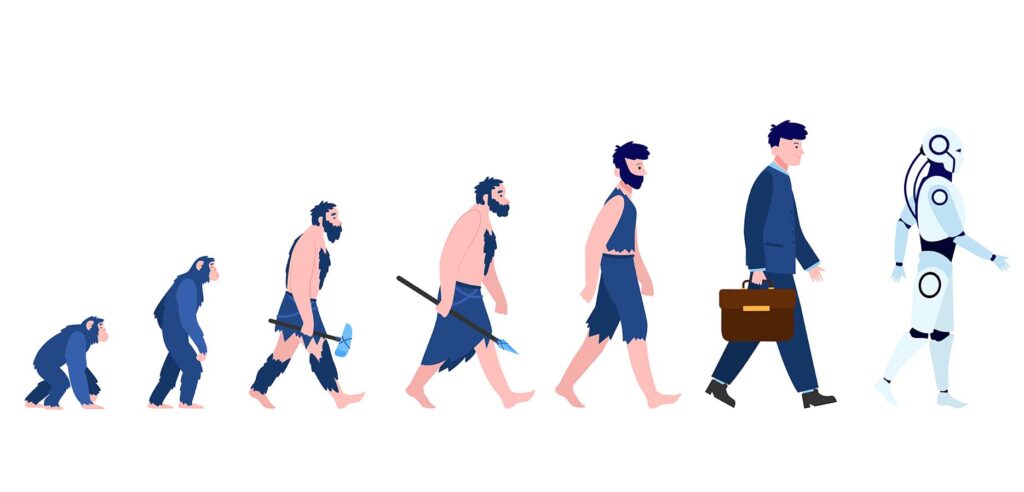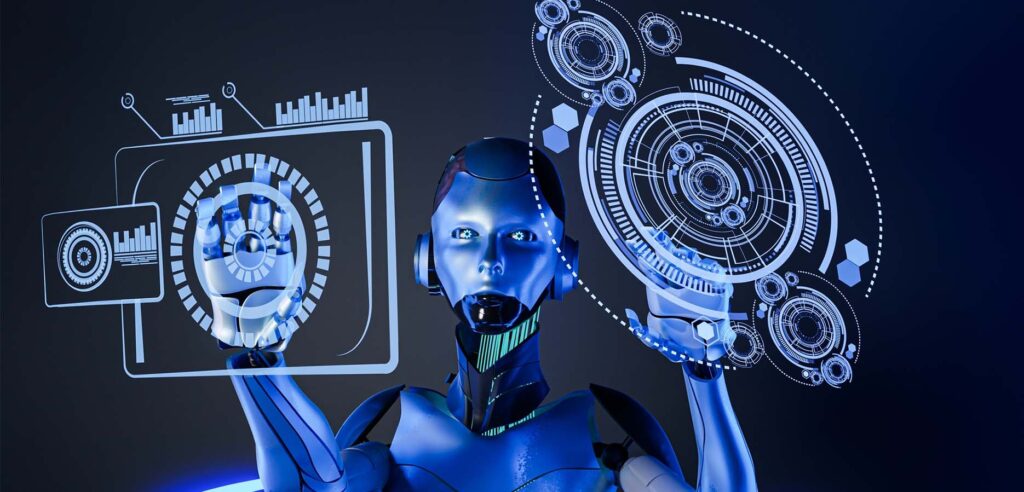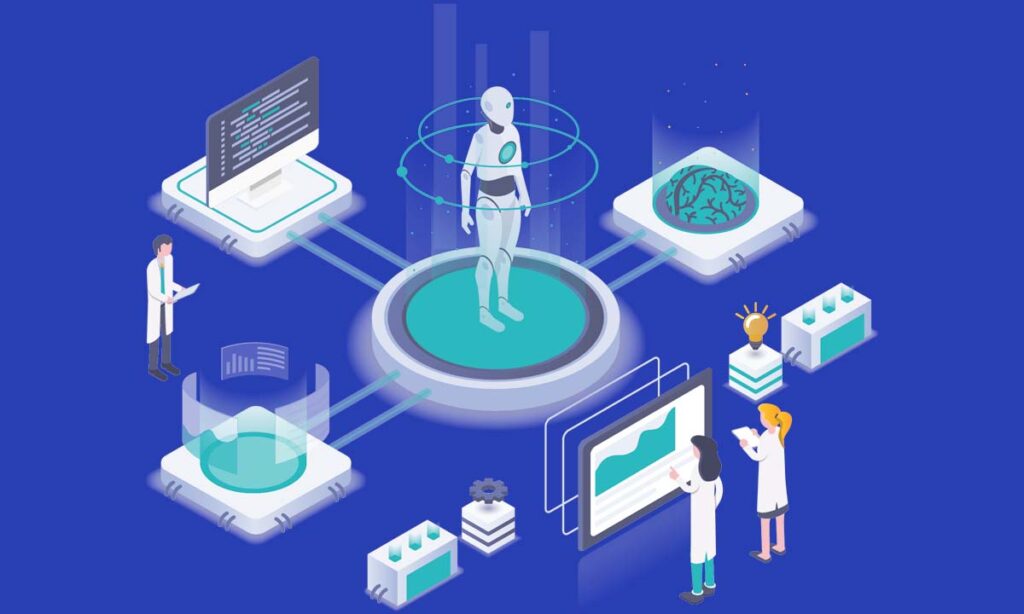Hey there! Have you heard of Artificial Intelligence (AI)? or What is AI. It’s a super cool term that’s been buzzing around lately in our fast-paced technological world. AI has become a part of our daily lives, changing the way we work, communicate, and interact with the world around us. But what exactly is AI? Let’s explore this fascinating world together and uncover its secrets!
An overview of Artificial Intelligence
AI stands for Artificial Intelligence. It involves developing computer systems that can perform tasks requiring human intelligence. These tasks include speech recognition, problem-solving, decision-making, and learning from experience. AI systems aim to replicate human cognitive abilities, allowing machines to analyse, understand, and respond to complex situations with minimal human intervention.
Difference between AI and Traditional Computing
Unlike traditional computer systems that rely on a predefined set of instructions to carry out tasks, artificial intelligence (AI) surpasses this approach by utilizing sophisticated algorithms and data. This allows machines to acquire knowledge from experience and enhance their performance as time goes on. In contrast to traditional computing, AI can adjust to new situations and enhance its responses through self-improvement mechanisms.
The Impact of AI in Our Daily Lives
AI has become deeply ingrained in different areas of our lives, integrating itself into essential applications and devices. From intelligent digital assistants such as Siri and Alexa to recommendation algorithms found on e-commerce platforms, AI algorithms tirelessly operate in the background, comprehending our preferences, anticipating our requirements, and improving our overall user experience. Whether it’s tailored content suggestions, accurate voice detection, or even self-driving cars, AI effortlessly merges with our everyday schedules, enhancing convenience and productivity.
The Evolution of AI

The AI has made significant progress since its beginning. Now, let’s delve into the various stages of its development, starting from rule-based systems to the most advanced methodologies.
From Rule-Based Systems to Machine Learning
Early artificial intelligence (AI) systems depended on rules and manually designed logic to make choices and carry out tasks. These systems, which were based on predefined rules, were effective in specific areas but had limited adaptability and faced difficulties in dealing with intricate and uncertain situations. Nonetheless, the field of AI witnessed a major breakthrough with the development of machine learning. Machine learning algorithms empowered computers to automatically learn from data, recognizing patterns, and generating data-led predictions or decisions.
The Emergence of Deep Learning and Neural Networks
Deep learning has advanced machine learning by simulating the operations of the human brain using artificial neural networks. These deep neural networks have the ability to analyze extensive datasets, uncovering significant characteristics and identifying intricate connections. This significant progress has resulted in notable improvements in areas such as computer vision, natural language processing, and other domains of artificial intelligence.
Reinforcement Learning and the Quest for Artificial General Intelligence (AGI)
Reinforcement learning is a method that allows machines to learn by interacting with their environment. It emulates the trial and error process humans use to learn, where the system is rewarded or punished based on its actions. This approach also aligns with the pursuit of Artificial General Intelligence (AGI), which seeks to create machines that can perform any intellectual task a human can.
Types of AI Systems

AI systems can be categorized into different groups according to their abilities and goals. Let us delve into these classifications to enhance our comprehension of the wide-ranging applications of AI.
Narrow AI: Understanding AI with Specific Applications
Narrow AI, which is also referred to as Weak AI, concentrates on accomplishing particular tasks within a clearly defined field. These AI systems thrive in their specialized area but have limitations when it comes to generalizing beyond their domain. Instances of narrow AI encompass algorithms for language translation, systems for image recognition, and voice assistants such as Apple’s Siri.
General AI: The Holy Grail of AI Development
General AI, also known as Strong AI, embodies the quest for machines with human-like intelligence in various domains. This AI type remains an ambitious endeavor, as researchers and scientists aim to develop systems capable of reasoning, adapting, and learning across diverse tasks. Accomplishing general AI necessitates machines to demonstrate genuine comprehension and consciousness, presenting philosophical and technical hurdles during the journey.
Super intelligent AI: Exploring the Limits of AI
Super intelligent AI, an extension of general AI, aims to surpass human intelligence in every aspect. Despite its seemingly science fiction nature, researchers are actively investigating the potentials and consequences of this innovative technology. Achieving cognitive capabilities beyond human capacity entails overcoming technological challenges and addressing ethical concerns regarding the governance and influence of these advanced AI systems.
The Building Blocks of AI

AI systems rely on three fundamental components that form the backbone of their functionality. Let’s unravel these building blocks to gain insight into the inner workings of AI.
Data: The Fuel of AI Systems
Data acts as the lifeblood of AI systems. To learn and make accurate predictions or decisions, AI algorithms require vast amounts of high-quality data. This data is analysed, cleaned, and transformed to extract meaningful insights and patterns. An extensive dataset fuels the learning process, enabling AI systems to become more accurate, insightful, and capable of sophisticated tasks.
Algorithms: Unleashing the Power of Data
While data provides the raw material for AI systems, algorithms serve as the tools that unlock its power. Algorithms dictate how data is processed, enabling AI systems to learn, recognize patterns, and make intelligent decisions. There are various algorithmic approaches, including decision trees, neural networks, and support vector machines, each suited for different types of tasks and data.
Computational Power: Enabling Complex AI Models
AI systems require substantial computational resources to manage the intricacy of contemporary algorithms and extensive datasets. High-performance computing systems, including GPUs (Graphics Processing Units), are utilized to execute intricate computations and handle vast quantities of data. This enables AI models to undergo faster training and attain superior performance levels. The advancement in computational power has played a pivotal role in pushing the frontiers of AI research and development.
Machine Learning in AI

Machine learning, which is a subset of AI, has a crucial role in allowing AI systems to acquire knowledge from data and enhance their performance progressively. Now, we will delve into the diverse categories of machine learning and discover their various applications.
Supervised Learning: Teaching AI through Labelled Data
Supervised learning involves training AI models using labelled datasets, where the input data and corresponding outputs are provided. The algorithm learns to map the inputs to the correct outputs, enabling it to make predictions on unseen data accurately. Supervised learning is widely used in tasks such as image classification, sentiment analysis, and recommendation systems.
Unsupervised Learning: AI Exploring Patterns on Its Own
Unsupervised learning algorithms, on the other hand, work with unlabelled data, allowing the AI system to discover patterns, relationships, and structures independently. This form of learning is particularly valuable in exploratory data analysis, clustering similar items, and dimensionality reduction of high-dimensional data.
Reinforcement Learning: AI Interacting with the Environment
Reinforcement learning entails training AI systems to make decisions through trial and error, similar to how humans learn from experiences. The AI agent engages with an environment, receiving rewards or penalties for its actions, and learns to enhance its behaviour to maximize long-term rewards. This learning approach has demonstrated considerable potential in various areas like game playing, robotics, and autonomous driving.
Deep Learning and Neural Networks

Deep learning, a subfield of machine learning, has revolutionized AI by simulating the functioning of the human brain through artificial neural networks. Let’s dive into the world of neural networks and their applications in AI.
Understanding Neural Networks
Neural networks are computational models inspired by the intricate structure of the brain’s neural connections. They consist of interconnected nodes, also called artificial neurons or units, organized in layers. Information flows through these layers, where each neuron processes inputs, applies mathematical operations, and passes the transformed information to the subsequent layer. This interconnectedness enables neural networks to tackle complex problems, such as image recognition and natural language processing.
Convolutional Neural Networks (CNN): AI in Image Analysis
Convolutional Neural Networks (CNN) excel in processing and analysing visual data, making them invaluable in image analysis tasks. CNN’s hierarchical architecture enables them to learn complex visual patterns by detecting edges, shapes, and textures at different levels. These networks have demonstrated remarkable performances in image recognition, object detection, and even medical imaging diagnosis.
Recurrent Neural Networks (RNN): AI in Language and Speech
Recurrent Neural Networks (RNN) are designed to analyse sequential data, making them ideal for language and speech-related tasks. Unlike traditional neural networks, RNNs incorporate feedback connections, allowing them to retain memory of previous inputs. This memory retention enables RNNs to model dependencies in time, making them effective in applications such as language translation, speech recognition, and sentiment analysis.
AI Applications in Different Fields

AI’s impact spans across various domains, transforming industries and enhancing productivity. Let’s explore some of the key areas where AI is making substantial contributions.
AI in Healthcare: Revolutionizing Diagnosis and Treatment
In healthcare, AI is revolutionizing medical diagnosis, drug discovery, and personalized treatment plans. AI systems can analyse vast amounts of patient data, such as medical records and imaging scans, to aid doctors in making more accurate diagnoses. Moreover, AI algorithms can identify patterns and predict outcomes, enabling early detection of diseases and tailoring treatment strategies based on individual patient characteristics.
AI in Finance: Transforming Investment and Risk Management
The finance industry has embraced AI to streamline operations, improve risk management, and enhance investment strategies. AI algorithms can analyse market trends, historical data, and real-time information to make data-driven predictions and optimize investment portfolios. Furthermore, AI-powered chatbots and virtual assistants are revolutionizing customer service in the finance sector, providing personalized recommendations and addressing inquiries efficiently.
AI in Transportation: Advancing Autonomous Vehicles
Autonomous vehicles represent one of the most significant advancements in the transportation industry, predominantly fuelled by AI. AI algorithms enable vehicles to perceive their surroundings, make real-time decisions, and navigate complex traffic scenarios without human intervention. Through AI, autonomous vehicles have the potential to enhance road safety, optimize traffic flow, and reduce environmental impact.
AI in Education: Personalizing Learning Experiences
AI is transforming the education landscape, allowing personalized learning experiences tailored to individual student needs. Adaptive learning platforms leverage AI algorithms to analyse students’ progress, identify strengths and weaknesses, and provide customized content and recommendations. AI-powered virtual tutors and intelligent grading systems also hold the promise of making education more accessible and efficient.
Ethical Considerations in AI

While AI presents remarkable opportunities for progress and innovation, it also raises ethical concerns that demand careful consideration. Let’s explore some of the ethical aspects associated with AI development.
Bias and Fairness in AI Systems
AI systems are only as unbiased and fair as the data they are trained on. Biases present in the data, such as gender or racial biases, can inadvertently be perpetuated by AI algorithms, leading to algorithmic discrimination. Ensuring fairness and equity in AI systems requires careful data collection and algorithmic design to mitigate biases and prevent discrimination.
Privacy and Security Concerns in AI
AI systems often rely on extensive personal data, raising privacy and security concerns. Safeguarding sensitive information and ensuring secure data handling practices is crucial to protect individuals’ privacy and prevent misuse of personal data. Organizations must prioritize robust security measures and adhere to ethical guidelines to mitigate these risks.
The Future of Work in an AI-Driven Society
As AI systems become more sophisticated, concerns about the future of work arise. Automation powered by AI has the potential to replace certain job roles, leading to workforce disruptions and job displacement. Society must address the challenges posed by this technological advancement, focusing on reskilling and upskilling initiatives to ensure a smooth transition into an AI-driven economy.
Failures and Limitations of AI

While AI has achieved remarkable successes, it is not immune to failures and limitations. Exploring instances where AI fell short helps us identify key lessons and areas for improvement.
AI Failures: High-Profile Cases and Lessons Learned
AI systems aren’t infallible and have faced some high-profile failures. Instances of AI-powered facial recognition software misidentifying individuals or autonomous vehicles involved in accidents highlight the inherent limitations of these systems. Such failures emphasize the need for continual monitoring, robust testing, and ongoing human oversight to improve AI’s reliability and safety.
The Black Box Problem: Interpreting AI Decisions
One of the challenges in AI lies in understanding the decision-making process of complex AI models. Often referred to as the black box problem, it involves the difficulty of interpreting and explaining AI’s decisions or predictions. This lack of interpretability raises concerns about biases, accountability, and potential risks associated with AI systems. Researchers are actively working on developing methods to address the black box problem and enhance transparency.
AI’s Limitations and Challenges Ahead
AI still faces significant limitations and challenges that hinder its progress. AI algorithms heavily rely on the data they are fed, making them susceptible to data limitations or biases. Additionally, AI systems often struggle with handling uncertain or previously unseen scenarios, hampering their adaptability. Continual advancements in AI research and investment in ethical AI development are necessary to overcome these limitations and address emerging challenges.
The Future of AI

The possibilities for AI development are vast, and its future holds great potential for innovation and transformation. Let’s explore what lies ahead in the realm of AI.
The Quest for Artificial General Intelligence (AGI)
Researchers and scientists are relentlessly pursuing the development of Artificial General Intelligence (AGI). This goal seeks to create AI systems capable of performing any intellectual task that a human being can do. Successful AGI would mark a significant turning point in AI development, transcending narrow AI systems and unlocking astonishing capabilities.
The Ethical Dilemmas of AGI Development
With the pursuit of AGI come ethical dilemmas and concerns. As machines inch closer to human-level intelligence, questions surrounding moral reasoning, consciousness, and decision-making authority arise. Addressing these ethical dilemmas is crucial to ensure AGI’s responsible development and secure its integration into society.
Exploring the Boundaries: Super intelligent AI
The boundaries of AI are continually being pushed, with scientists venturing into the realm of super intelligent AI. The concept of machines surpassing human intelligence triggers thoughts of unprecedented technological advancements and unimaginable possibilities. Beyond AGI, the exploration of super intelligent AI raises fundamental questions about our relationship with technology and the safeguards necessary to prevent unintended consequences.
Summary
In this article, we have unveiled the enigmatic world of AI. We have explored its definition, evolution, applications, limitations, and future prospects. We have dissected the building blocks of AI, delved into machine learning techniques, and examined the fascinating realm of deep learning and neural networks. Additionally, we have discussed how AI is transforming various fields, considered ethical implications, and analysed its failures and limitations. Finally, we have envisioned the future of AI, from the pursuit of AGI to the ethical dilemmas and super intelligent AI. The potential of AI is immense, and as we navigate this rapidly evolving field, it is essential to continue exploring, learning, and engaging with AI to unlock its limitless possibilities.
FAQs
What is AI Artificial Intelligence ?
Artificial Intelligence (AI) refers to the development of computer systems that possess human-like intelligence and can perform tasks that typically require human thought and reasoning.
How is AI different from traditional computing?
Unlike traditional computing, AI systems go beyond pre-programmed instructions, utilizing advanced algorithms and data to learn, adapt, and improve their performance over time. AI systems can analyse, understand, and respond to complex situations, while traditional computing relies on fixed rules and predetermined instructions.
What are the different types of AI systems?
AI systems can be categorized into Narrow AI, which specializes in specific tasks, General AI, which strives to replicate human-like intelligence across multiple domains, and Super intelligent AI, envisioning machines surpassing human intelligence in every aspect.
How does machine learning contribute to AI?
Machine learning, a subset of AI, enables AI systems to learn from data and improve their performance through experience. By utilizing algorithms, machine learning allows computers to automatically extract meaningful patterns and relationships from vast amounts of data.
What are the applications of AI in different fields?
AI has diverse applications across various fields. In healthcare, it’s revolutionizing diagnosis and personalized treatment. Finance benefits from AI in investment strategies and risk management. The transportation industry is advancing through autonomous vehicles. In education, AI personalizes learning experiences for students.

A Beginner’s Guide to Understanding What is AI ?